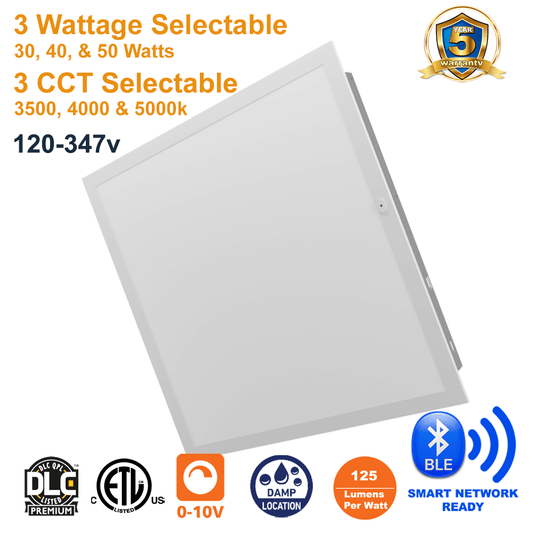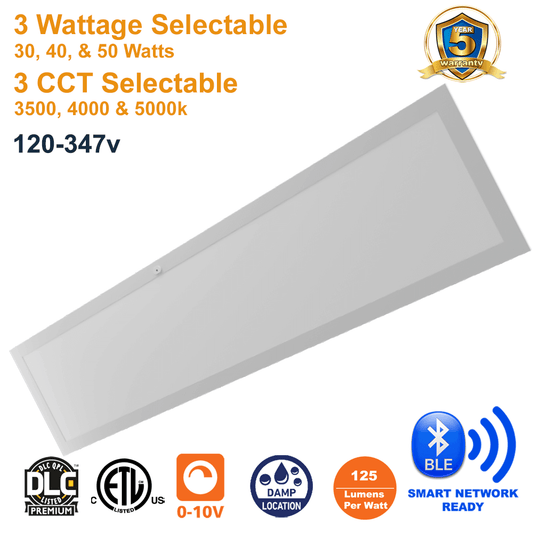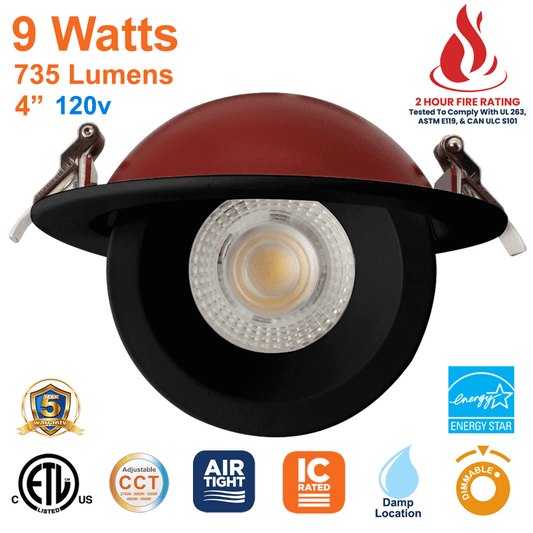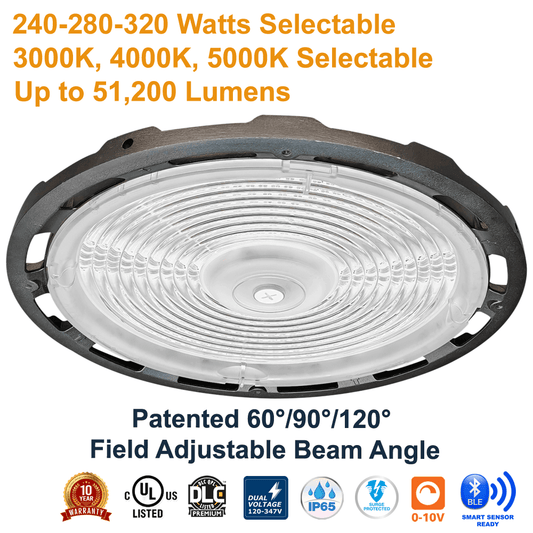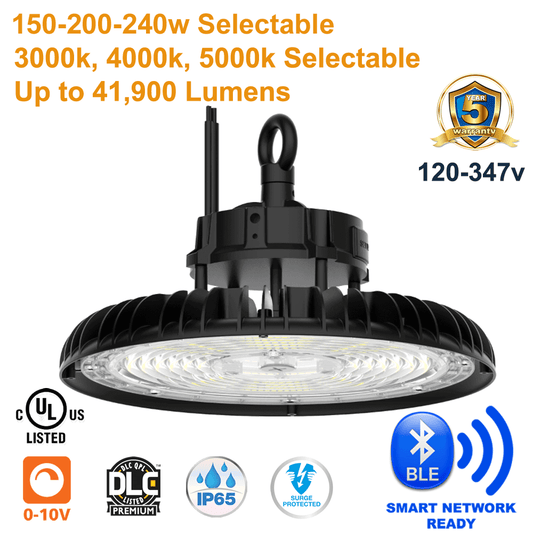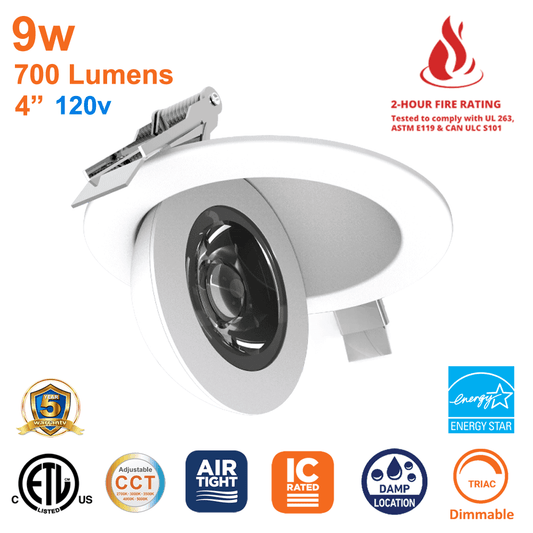Fire-rated downlights are a critical safety feature for residential and commercial buildings, designed to prevent fire spread through ceiling penetrations. In this guide, we’ll break down the meaning of 30, 60, and 90-minute fire ratings in simple terms. You'll learn when and where different ratings are required, how to identify compliant products, and why it's not just about building regulations—but peace of mind. We’ll also cover installation safety, how to avoid fire hazards, and what sets a quality downlight apart. Whether you’re doing a new build or replacing existing lighting, this article will help you make the safest and most efficient choice for your space.
What Are Fire-Rated Downlights?
When you install any type of recessed lighting into a ceiling, you're creating a ceiling breach—a weak point where fire can quickly pass from one room or floor to the next. That’s where fire-rated downlights come in. These fixtures are engineered to preserve the fire integrity of your ceiling by sealing off the hole they occupy in the event of a fire.
This protection comes courtesy of intumescent pads, materials that expand rapidly under heat, closing the gap and significantly slowing fire penetration. Fire-rated downlights are tested to withstand flames for defined periods—30, 60, 90 minutes, and sometimes even 120-minute protection—depending on the product and the building’s structural needs.
“The hole you cut for a downlight may seem small—but in a fire, it can become a superhighway for flames.”
To understand how this plays out practically, consider a loft conversion lighting project. A ceiling separating a loft from the living area below must maintain its fire resistance just as a solid, unbroken ceiling would. Without a proper downlight, fire could breach that barrier in moments.
When Do You Need 30, 60 or 90-Minute Ratings?
Different parts of a building require different levels of fire protection. The fire rating of a downlight reflects how long it can delay the spread of fire. Here’s a simple breakdown:
-
30-minute fire rating: Usually suitable for ground floor ceilings with minimal escape complexity.
-
60-minute fire rating: Commonly required for upper floors, especially where evacuation routes must be preserved.
-
90-minute fire rating: Often needed for commercial fire-rated lighting, or in high-occupancy residential builds.
-
120-minute fire rating: Used in specialist or high-risk environments for extended protection.
These requirements aren’t just best practices—they’re often governed by building regulations, particularly Part B building regs in the UK or similar local codes in Canada. Fire-rated downlights that are LPCB approved or compliant with BS 476 Part 21 have been tested to meet stringent performance standards.
If you’re unsure which rating is appropriate for your project, start by visiting our Fire-Rated Pot Lights Collection for certified lighting solutions.
Choosing the Right Fire-Rated Downlight
Choosing the correct product isn’t just about fire rating—it's about compatibility with your space, compliance, and installation safety. Here’s what to consider:
1. Size and Fit
-
3-Inch Fire-Rated Pot Light – 2-Hour Rated: Ideal for tight ceiling voids or minimalist designs.
-
4-Inch Fire-Rated Pot Light – IC & Wet Rated: A great mid-size choice for bathroom downlight safety or domestic ceiling lighting.
2. CCT Selectability and Dimming
Look for modern variants with selectable color temperatures and dimming capabilities to match ambiance with safety.
3. IC and Wet Rating
Ensure the light is IC rated for insulation contact and IP rated for areas exposed to moisture like bathrooms or kitchens.
4. Fire Test Certification
Products should clearly include a product description outlining their tested fire rating. Anything not labelled downlights should be avoided.
We offer 6-inch fire-rated downlights for broader lighting coverage and projects requiring more lumens, such as stairwell fire protection.
What Happens if You Skip the Fire Rating?
Standard downlights—those without a fire rating—can contribute to the rapid fire spread between building levels. They offer no resistance to heat or flame, and worse, may collapse or allow fire to break through in just a few minutes.
It’s also worth noting that improper DIY installations can void warranties and even break code, increasing the fire hazard. For peace of mind and safety, always use a registered electrician for installation.
Fire safety isn’t just about the fixture; it’s about the full system—structure, compliance, and proper setup.
Understanding the Types of Fire-Rated Downlights
Now that we’ve covered what fire ratings mean and why they matter, let’s explore the types of fire-rated downlights available, how they differ, and which ones are most suitable depending on your project needs.
Integrated LED vs GU10 Fire-Rated Fittings
When choosing between integrated LED downlights and GU10 fire-rated fittings, consider the following:
-
Integrated LED downlights are all-in-one units where the LED is built into the fixture. These tend to offer better energy efficiency, longer lifespan, and improved heat management.
-
GU10 fire-rated fittings allow you to replace the bulb independently. This gives flexibility but can reduce efficiency over time if not paired with the right lamps.
For most residential projects and renovation work, integrated LEDs offer a streamlined, low-maintenance solution. However, if flexibility or budget is a major concern, GU10 fittings remain a valid option when used correctly.
At LED Network, we offer advanced fire-rated solutions that blend both efficiency and compliance, ensuring no compromises between safety and lighting quality.
Adjustable Fire-Rated Downlights
Adjustable fire-rated downlights—also called gimbal or tiltable downlights—are ideal for accent lighting and sloped ceilings. They allow you to angle the light source to highlight artwork, architectural details, or task areas. But be cautious: not all adjustable fittings maintain their fire compartmentalisation unless specifically designed and certified to do so.
Always verify whether the product description confirms fire testing, especially for adjustable units. This ensures that despite the moving parts, the ceiling integrity remains uncompromised during a fire.
Acoustic and Insulation-Compatible Downlights
Acoustic-rated downlights offer an additional benefit in multi-occupancy buildings by reducing sound transmission through ceiling penetrations. This is particularly important in loft conversion lighting or apartments, where privacy and noise control are just as important as fire safety.
Meanwhile, insulation cover compatible downlights—often labelled as IC rated—are designed for safe installation where thermal insulation is present in the ceiling. Improper insulation handling can lead to overheating and potential fire hazards.
So, when planning your layout, ensure that the product supports both acoustic integrity and thermal compatibility if required.
Where Should You Install Each Fire Rating?
Let’s clarify how to apply 30, 60, and 90-minute fire ratings based on building structure:
| Location | Minimum Fire Rating | Notes |
|---|---|---|
| Ground floor ceiling | 30 minutes | Shorter escape routes |
| Between floors in a house | 60 minutes | Preserve evacuation route |
| Top floor with roof above | 90 minutes | Increased evacuation time |
| Apartment blocks & stairwells | 90–120 minutes | High occupancy; long exits |
In stairwell fire protection, for example, choosing a 2-hour fire-rated LED downlight adds a layer of protection that could be life-saving.
Fire-Rated Downlights in Wet Zones
If you’re installing lighting in kitchens, bathrooms, or covered outdoor areas, it’s essential to choose a wet-rated downlight with the appropriate IP rating. This ensures moisture doesn’t compromise electrical safety or the fixture's fire protection features.
For example, our 4-inch wet-rated LED downlight offers both fire and water resistance, making it perfect for bathroom downlight safety and kitchen zones.
Beyond Regulation: Why Fire-Rated Downlights Are Essential
While building regulations set the minimum requirement, real-world scenarios often demand a higher standard of care. It’s not just about avoiding penalties—it’s about protecting lives, reducing fire spread, and safeguarding your property investment.
Consider:
-
Insurance claims may be affected if non-compliant lighting is installed.
-
DIY shortcuts may void product warranties and create dangerous fire hazards.
-
Homes with vulnerable individuals or complex evacuation paths benefit significantly from higher fire resistance.
In short: the right fire-rated downlight does more than meet code—it buys time when every second counts.
Ensuring Safe & Compliant Installation
Even the best fire-rated downlights can fail to protect if they're installed incorrectly. That’s why proper installation safety is as critical as the product itself. A registered electrician should always handle the wiring and mounting, especially when ceiling insulation or fire barriers are involved.
Key Installation Tips:
-
Respect Ceiling Integrity
Cutouts must be exact. Oversized holes or poor fittings can compromise fire resistance, making even certified downlights ineffective. -
Use IC-Rated Fixtures Where Required
When insulation is present, use IC-rated lights like our 6-inch fire-rated downlight, which can safely operate in contact with insulation. -
Avoid DIY Installations
It might be tempting to install downlights yourself, especially for minor renovations. But poor wiring, wrong product selection, or disrupting fire barriers can become serious fire hazards. Always opt for professional installation. -
Check for Certification
Verify that your lights are compliant with standards like BS 476 Part 21, or equivalent North American standards (such as UL 263). This ensures they’ve been tested under real fire conditions for fire penetration resistance and fire integrity.
Product Labels Matter More Than You Think
A properly labelled downlight gives you confidence in its capabilities. Key details to look for include:
-
Duration of fire rating (e.g., “120-minute protection”)
-
Wet or damp location certification
-
IC rating
-
Voltage and wattage
-
Certifications (e.g., ETL, cETLus, or UL for North America)
Not all products in the market live up to their claims. That’s why we make it easy at LED Network by transparently listing product specs, certifications, and application guidelines on every listing.
Final Thoughts: Why Fire-Rated Downlights Are Worth It
Choosing fire-rated downlights is about more than meeting code. It’s about building smarter, safer homes and workspaces that protect the people inside.
To recap:
-
30, 60, and 90-minute fire ratings correspond to different structural needs. Match the rating to the floor level, usage, and evacuation time.
-
Look for features like intumescent pads, wet ratings, and IC compatibility to ensure safety from every angle.
-
Only buy from trusted sources with transparent product info and proven certifications.
-
Always use a registered electrician to preserve compliance and performance.
For an easy place to start, browse our Fire-Rated Pot Lights Collection for options ranging from compact 3-inch models to full-coverage 6-inch LED solutions.
One Light, Multiple Responsibilities
Remember: a fire-rated downlight isn’t just a light. It’s part of your fire safety system, part of your insulation plan, and part of your building's long-term resilience.
Whether you're upgrading an old ceiling or specifying lighting for a new build, choosing the right downlight is one of the simplest yet most powerful decisions you can make.
Frequently Asked Questions: Fire-Rated Downlights (30, 60, 90 Minutes)
1. What is the difference between fire-rated and non-fire-rated downlights?
Fire-rated downlights are specifically engineered to restore the fire integrity of a ceiling after a hole is cut for lighting. Non-fire-rated downlights lack this protection and can allow fire to spread rapidly between floors or rooms.
2. Are fire-rated downlights required by law in Canada?
While requirements vary by province and municipality, many building codes and inspection authorities recommend or require fire-rated downlights when installing recessed lighting in ceilings that form a fire barrier—such as between floors in multi-story homes or buildings.
3. Can I install fire-rated downlights in ceilings with spray foam or blown insulation?
Yes, but only if the downlights are IC-rated (insulation contact rated). Using non-IC-rated lights in these situations may create overheating risks and void both product warranties and building code compliance.
4. Are all fire-rated downlights dimmable?
No. While many modern models—such as our 4-inch fire-rated dimmable downlight—support dimming, it's not guaranteed. Always check the product specifications to confirm.
5. What is the lifespan of a fire-rated downlight?
Most high-quality integrated LED fire-rated downlights have a lifespan of 25,000 to 50,000 hours, depending on usage and environmental conditions. Regular cleaning and proper installation extend this lifespan.
6. Can I use fire-rated downlights outdoors?
Only if they have an appropriate IP rating (such as IP65 or higher) for moisture and dust resistance. Indoor fire-rated downlights are not automatically weatherproof and may fail if exposed to the elements.
7. Do fire-rated downlights make the room warmer or affect insulation performance?
No—modern fire-rated and insulation-compatible downlights are designed to minimise heat loss and are often thermally sealed. In some cases, they can actually help maintain energy efficiency by preventing drafts.
8. How do I know if a fire-rated downlight is certified?
Look for certifications such as cETL, UL 263, or specific fire testing references like BS 476 Part 21. These confirm the product has undergone official fire resistance testing. All compliant downlights should also include clear labelled documentation.
9. What happens to a fire-rated downlight during a fire?
When exposed to extreme heat, the intumescent materials inside the downlight expand, sealing the hole in the ceiling to prevent the upward spread of flames. The fixture is designed to stay intact for its rated time (e.g. 30, 60, or 90 minutes), maintaining the structure’s fire compartmentalisation.
10. Can I replace just the bulb in an integrated fire-rated downlight?
No. Integrated LED downlights are sealed units where the LED is built-in. Once the LED reaches the end of its lifespan, the entire fixture is typically replaced. However, they are extremely long-lasting and energy-efficient, which often offsets this limitation.





